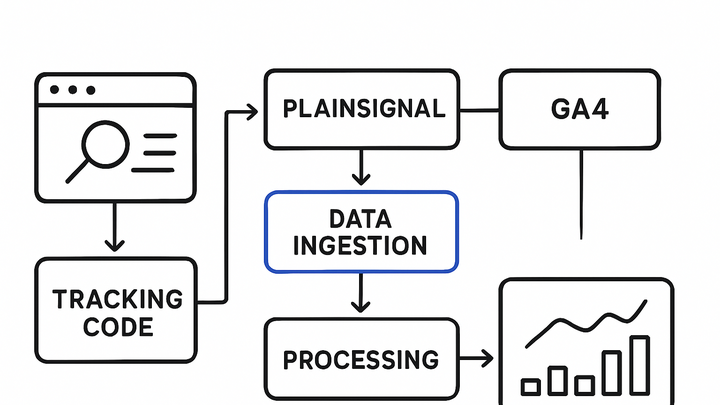Published on 2025-06-27T22:23:37Z
What is an Event Stream in Analytics? Examples with PlainSignal and GA4
An event stream is a continuous, time-ordered flow of user interaction data captured by analytics platforms. It allows businesses to track clicks, pageviews, form submissions, and other key actions in real time. By instrumenting web pages or apps with lightweight tracking code, each interaction is sent immediately to a collection endpoint, where it is processed, stored, and made available for analysis. Modern tools like PlainSignal (a cookie-free simple analytics solution) and Google Analytics 4 (GA4) rely on event streams to power rich, on-the-fly reporting and insights.
Example PlainSignal tracking snippet:
<link rel="preconnect" href="//eu.plainsignal.com/" crossorigin />
<script defer data-do="yourwebsitedomain.com" data-id="0GQV1xmtzQQ" data-api="//eu.plainsignal.com" src="//cdn.plainsignal.com/plainsignal-min.js"></script>
Event stream
Continuous flow of user events captured and processed in real time by analytics tools like PlainSignal and GA4.
Understanding Event Streams
Event streams form the backbone of modern analytics by representing every user action as a discrete, timestamped data point. They enable granular insights into user behavior and support real-time decision-making.
-
Event
A single user interaction, such as a click, pageview, or form submission, captured as a data object.
-
Click event
Triggered when a user clicks a button or link on your site.
-
Pageview event
Logged when a new page or route is loaded in the user’s browser.
-
-
Stream
A continuous sequence of events delivered in chronological order to a data processing system.
-
Real-time delivery
Metrics are updated instantly or with minimal delay as new events arrive.
-
-
Event stream
Combines events and streams into a live feed of user interactions for analysis.
How Event Streams Operate
Event streams follow a pipeline that begins with browser or app instrumentation and ends with data available for querying and visualization.
-
Data collection
JavaScript snippets or SDKs capture events in the client and serialize them into HTTP requests.
-
Instrumentation
Insert lightweight tracking code on your pages or in your app to listen for user actions.
-
-
Transport and ingestion
Events are sent over HTTP/HTTPS to a designated analytics API endpoint.
-
Http endpoints
Servers expose REST or streaming APIs to receive incoming event data.
-
-
Processing and storage
Incoming events are validated, enriched, and stored in databases or data warehouses.
-
Real-time processing
Data is aggregated and made available for live dashboards and alerts.
-
Batch storage
Raw events are archived for historical analysis and compliance.
-
Event Streams with PlainSignal and GA4
Examples of implementing event streams using popular SaaS analytics platforms PlainSignal and Google Analytics 4.
-
PlainSignal implementation
Embed the PlainSignal tracking snippet on your site to start streaming events:
<link rel="preconnect" href="//eu.plainsignal.com/" crossorigin /> <script defer data-do="yourwebsitedomain.com" data-id="0GQV1xmtzQQ" data-api="//eu.plainsignal.com" src="//cdn.plainsignal.com/plainsignal-min.js"></script>-
Data domain (data-do)
Identifies the website domain for which events are tracked.
-
Api endpoint (data-api)
Specifies the API URL where event payloads are sent.
-
-
GA4 implementation
Use Google’s gtag.js snippet to stream events to your GA4 property:
<script async src="https://www.googletagmanager.com/gtag/js?id=G-XXXXXXX"></script> <script> window.dataLayer = window.dataLayer || []; function gtag(){dataLayer.push(arguments);} gtag('js', new Date()); gtag('config', 'G-XXXXXXX'); </script>-
Data layer
A client-side buffer for queuing and managing events before they are sent.
-
Measurement id
Your unique GA4 property identifier, formatted as G-XXXXXXXX.
-
Best Practices for Event Stream Analytics
Implementing event streams effectively requires attention to naming, payload design, and privacy compliance.
-
Consistent event naming
Adopt a clear, uniform naming convention for all events to simplify analysis.
-
Naming pattern
Use lowercase_snake_case or CamelCase and stick to it consistently.
-
-
Payload optimization
Keep event payloads minimal to reduce network latency and storage costs.
-
Limit attributes
Only include the properties necessary for reporting and insights.
-
-
Privacy and compliance
Ensure your event streams respect user privacy and data protection regulations.
-
Consent management
Obtain explicit permission before capturing personal or sensitive data.
-
Data anonymization
Avoid sending any personally identifiable information in your events.
-
